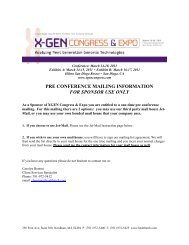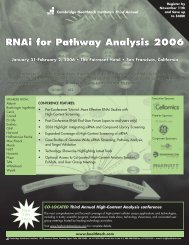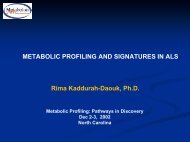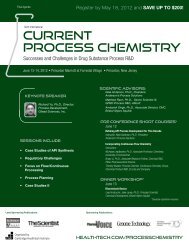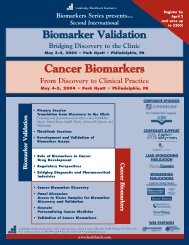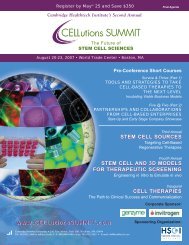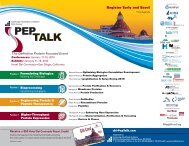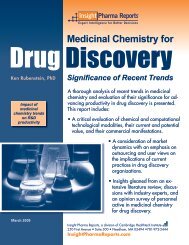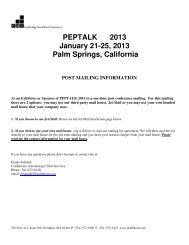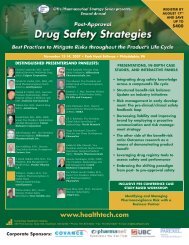Structure-Based Drug Design Conference Final Brochure.pdf
Structure-Based Drug Design Conference Final Brochure.pdf
Structure-Based Drug Design Conference Final Brochure.pdf
- No tags were found...
You also want an ePaper? Increase the reach of your titles
YUMPU automatically turns print PDFs into web optimized ePapers that Google loves.
characterizing critical waters (e.g. tight-binding), assessing the affinities<br />
of small molecule fragments, and identifying hot spots in proteinprotein<br />
interaction targets.<br />
4:10 Next-Generation Shape Signatures: A Powerful Tool for<br />
Fragment-<strong>Based</strong> <strong>Drug</strong> Discovery<br />
Randy Zauhar, Ph.D., Associate Professor, Chemistry & Biochemistry,<br />
University of the Sciences<br />
The original Shape Signatures method uses a ray-tracing approach to<br />
efficiently explore the volume and surface properties of a molecule.<br />
In our new approach, molecules are automatically partitioned into<br />
fragments, and the Shape Signatures descriptors are now likewise<br />
fragment-based. Query and target molecules are now compared by<br />
matching fragment in all ways compatible with the underlying structure.<br />
4:35 Panel Discussions:<br />
Topic: What are the challenges and opportunities for the next<br />
stages of development in fragment-based methods<br />
For many targets, the identification of fragments that bind is for<br />
the most part a solved problem. There are two main issues for the<br />
methods. The first is deciding which fragments to take forward – there<br />
can be hit rates of 5-10% for some targets. The second is how to guide<br />
the early stages of chemical optimisation in the absence of crystal<br />
structures, which is a particular problem for challenging targets such<br />
as protein-protein interactions. The discussion will ask for opinions<br />
on how computational methods could tackle these issues and what<br />
developments are still needed.<br />
5:00 Networking Cocktail Reception in the Exhibit Hall with<br />
Poster Viewing<br />
6:00 End of Day<br />
FRIDAY, JUNE 10<br />
HIGH PERFORMANCE COMPUTING AND<br />
COLLABORATIVE DRUG DESIGN<br />
8:10 am Chairperson’s Opening Remarks<br />
Jonathan Essex, Ph.D., Head, Computational Systems Chemistry;<br />
Chairman, Institute for Complex Systems Simulation (ICSS), School of<br />
Chemistry, University of Southampton<br />
8:15 Molecular Dynamics <strong>Drug</strong> Docking: Modeling Ligand<br />
Interactions in the Age of High Performance Computing<br />
Michael Kuiper, Ph.D., Computational Scientist, Victorian<br />
Partnership for Advanced Computing<br />
Continuing advances in computational performance now<br />
allow researchers to routinely simulate protein molecules<br />
in the order of hundreds of nanoseconds. At this timescale<br />
it is possible to investigate detailed interactions of ligands<br />
with receptors starting with the free ligand in solution. Though not<br />
yet suitable for high-throughput drug screening, molecular dynamics<br />
drug docking (MDDD) however does offer researchers an approach to<br />
observe complex drug/ligand interactions not typically considered in<br />
drug design.<br />
8:40 The Internet is Here to Stay: Web Service Delivery of<br />
Computational Properties<br />
David Thompson, Ph.D., Senior Principal Systems Engineer,<br />
Boehringer Ingelheim GmbH<br />
A robust and extensible web services framework for the<br />
delivery of computational properties to the medicinal<br />
chemist’s desktop will be presented. This architecture fully<br />
leverages our High Performance Compute environment,<br />
exposes a wide variety of computational engines, and can be utilized<br />
in a manner that best fits the scientists’ requirements. Use cases<br />
including the consumption of in silico physicochemical properties and<br />
the distribution of quantitative structure-activity relationship (QSAR)<br />
models will be described.<br />
FREE ENERGY APPROACH TO<br />
STRUCTURE-BASED DRUG DESIGN<br />
9:05 The Binding Energy Distribution Analysis Method<br />
(BEDAM) for <strong>Structure</strong>-<strong>Based</strong> <strong>Drug</strong> <strong>Design</strong>: Theory and<br />
Applications<br />
Ronald M. Levy, Ph.D., Board of Governors, Professor of Chemistry &<br />
Chemical Biology, Rutgers University<br />
The binding energy distribution analysis method (BDEAM) for structurebased<br />
drug design is a new approach to computing protein-ligand<br />
binding free energies which makes use of replica exchange molecular<br />
dynamics simulations to compute absolute binding affinities. The<br />
balance between binding enthalpy and entropy is seen in our formalism<br />
as a balance between unfavorable and favorable binding modes. Both<br />
the theory and application of BEDAM will be discussed.<br />
9:30 Fragment-<strong>Based</strong> Screening by Free Energy Simulations<br />
Jonathan Essex, Ph.D., Head, Computational Systems<br />
Chemistry; Chairman, Institute for Complex Systems<br />
Simulation (ICSS), School of Chemistry, University of<br />
Southampton<br />
Free energy simulation is potentially a very powerful tool<br />
for structure-based drug discovery. In this presentation,<br />
the application of a number of these techniques to locate and score<br />
molecular fragments and water in protein binding sites are described.<br />
These approaches offer advantages over more conventional simulation<br />
methods in that not only is fragment binding ranked in terms of<br />
free energy (i.e. entropy is included), but all fragments are in direct<br />
competition with water for the binding site.<br />
9:55 A New Computational Method for Predicting Binding<br />
Free Energies of Protein-Ligand Interactions<br />
Christopher Langmead, Ph.D., Associate Professor of Computer Science,<br />
Carnegie Mellon University<br />
This presentation will discuss a new computational method, called<br />
GOBLIN, for performing physics-based free energy calculations under<br />
protein and ligand flexibility. GOBLIN compactly encodes Boltzmann<br />
distributions over structures by exploiting conditional independencies.<br />
Results on HIV-1 PR will be presented demonstrating that it achieves<br />
superior quantitative accuracy than competing methods.<br />
10:20 Small Covalent Peptidomimteic Inhibitors of Crm1<br />
Mediated Nuclear Transport<br />
Sharon Shechter, Head of Computational Discovery, Karyopharm<br />
Therapeutics Inc<br />
Nucleo-cytoplasmic transport of macromolecules is a fundamental<br />
process of eukaryotic cells. Translocation of proteins and many RNAs<br />
between the nucleus and the cytoplasm is carried out by shuttling<br />
import and export receptors. CRM1 (Xpo1) is a major exporter<br />
for proteins from the nucleus to the cytoplasm, including tumor<br />
suppressors (TSPs) and other growth regulatory proteins (GRPs).<br />
Here, we describe the identification of novel Crm1 inhibitors using<br />
computational, hierarchical structure-based discovery process.<br />
10:35 Networking Coffee Break in the Exhibit Hall with Poster<br />
Viewing<br />
»»<br />
KEYNOTE PRESENTATION<br />
11:00 Millisecond-Long Molecular Dynamics Simulations of<br />
Proteins on a Special-Purpose Machine<br />
David E. Shaw, Ph.D., Chief Scientist, D. E. Shaw Research<br />
and Senior Research Fellow, Center for Computational<br />
Biology and Bioinformatics, Columbia University<br />
Molecular dynamics simulation provides a potentially<br />
powerful tool for understanding the behavior of proteins<br />
at an atomic level of detail, but its relevance to drug<br />
design has previously been limited in part by the computational<br />
demands of such simulations. We have constructed a specialized<br />
supercomputer, called Anton, that has simulated the behavior<br />
of a number of proteins for periods as long as a millisecond --<br />
approximately 100 times the length of the longest such simulation<br />
previously published -- revealing pharmaceutically relevant aspects<br />
of protein dynamics that were previously inaccessible to both<br />
computational and experimental study.<br />
11:45 SZMAP: Mapping Solvent Sponsored by<br />
Thermodynamics in Binding Sites<br />
Anthony Nicholls, Ph.D., President & CEO,<br />
OpenEye Scientific Software<br />
Semi-continuum solvent theory captures discrete effects that can<br />
be important in enclosed spaces such as binding cavities. Using this<br />
model, SZMAP rapidly maps thermodynamic quantities of water<br />
molecules near protein surfaces by employing a single explicit water<br />
probe. The resulting quantities may be used as a correction factor for<br />
continuum solvent calculations as well as serving to guide the design<br />
of ligand analogues and optimizing binding affinity.<br />
4<br />
healthtech.com/SBD



